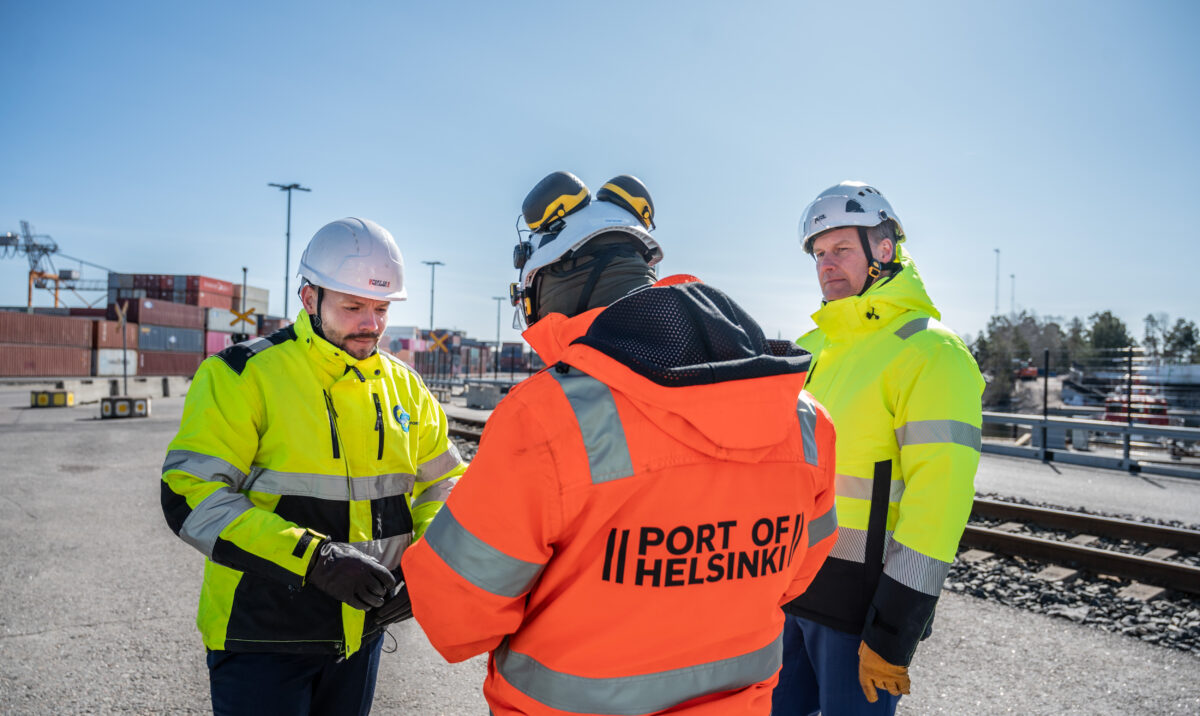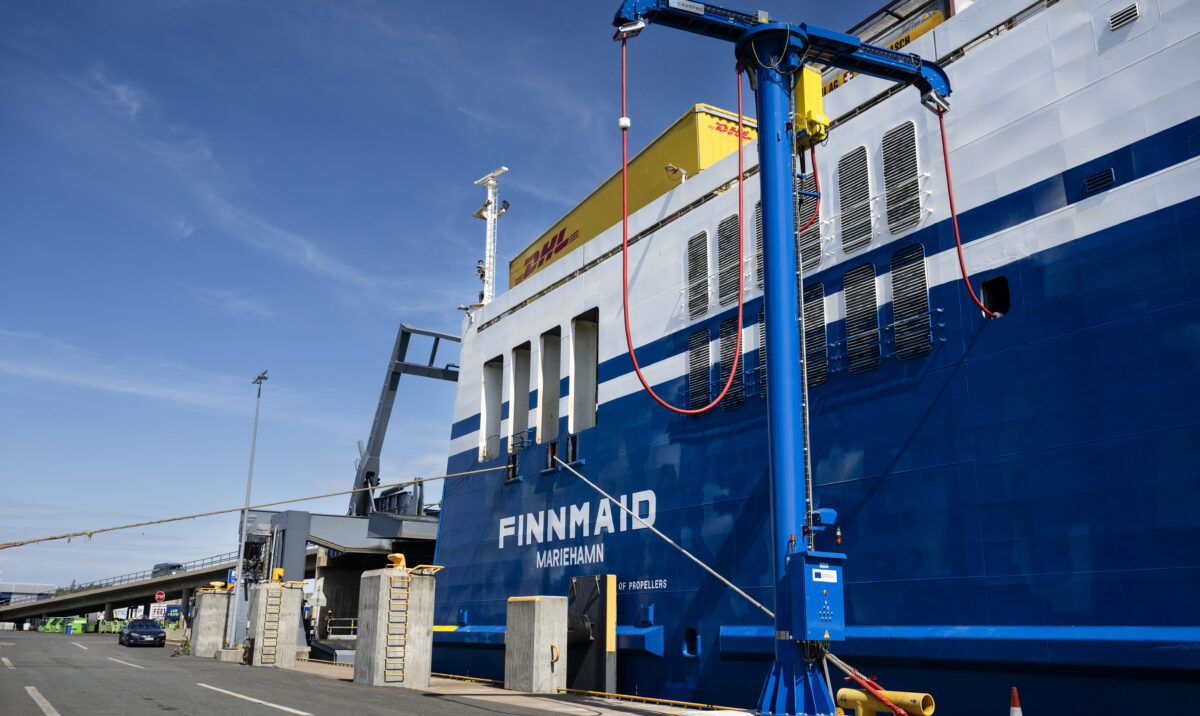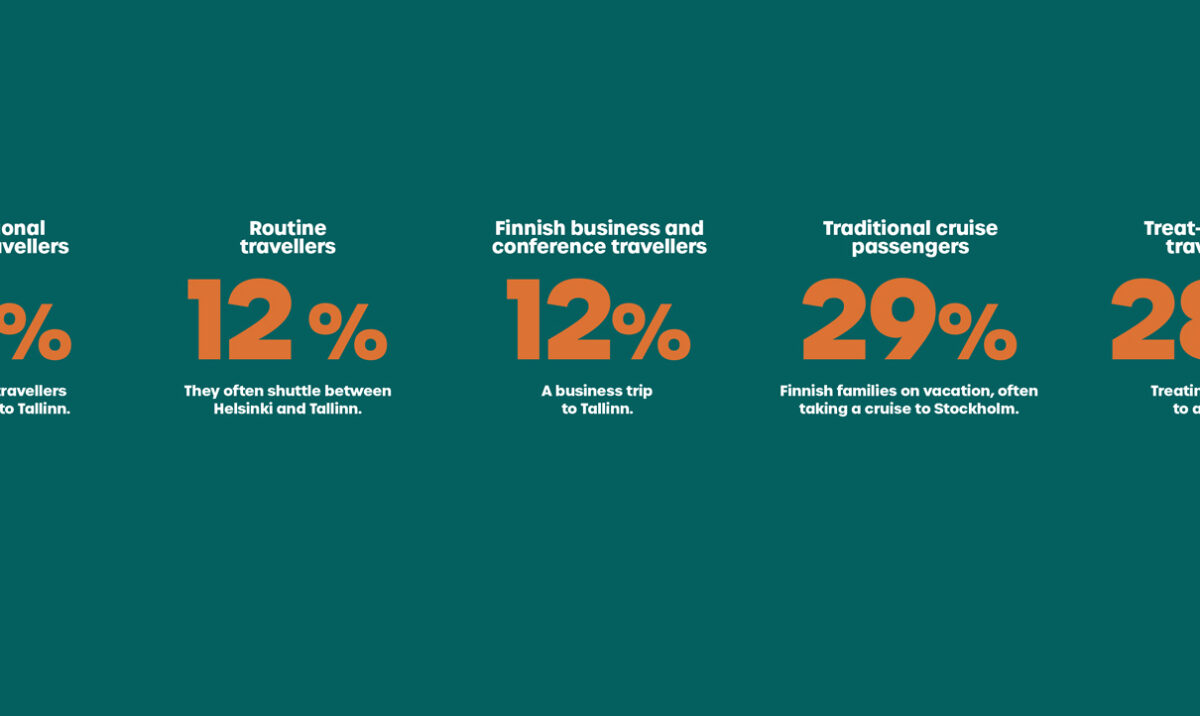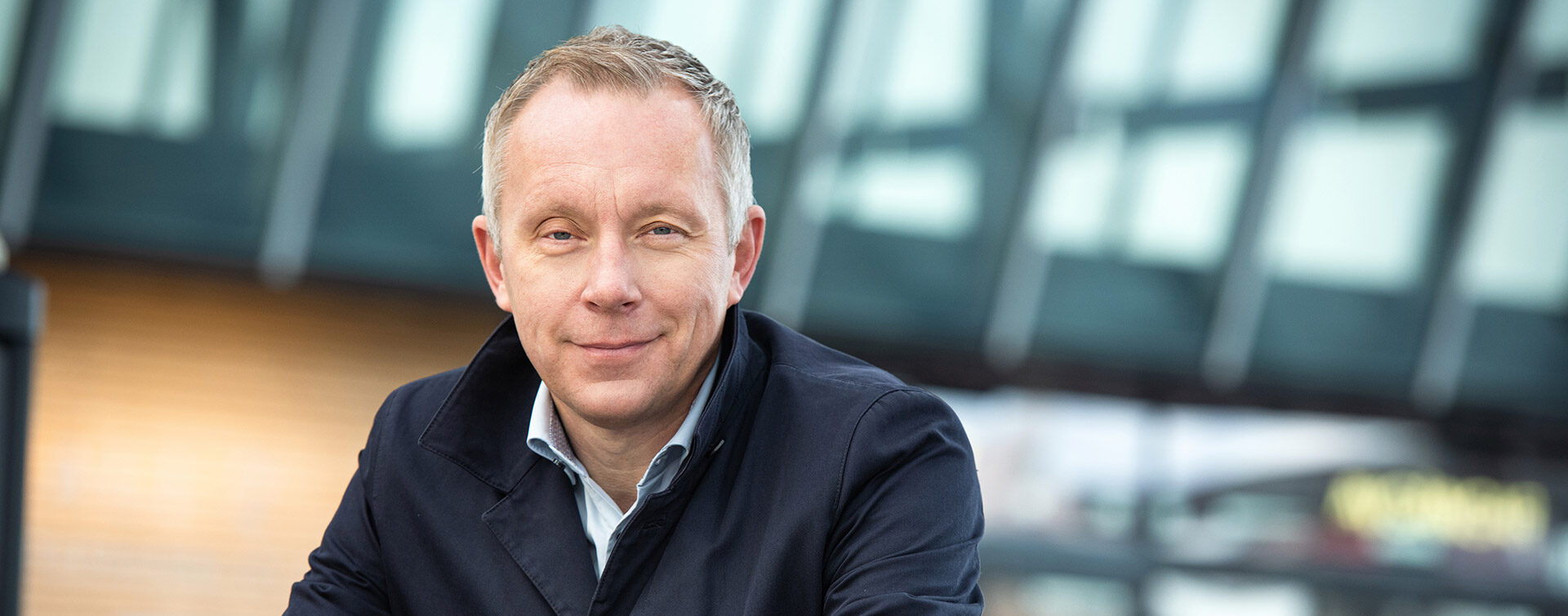
For sustainable growth
The Port of Helsinki’s strategy is aiming for sustainable growth. And as the port exists for its customers, this growth must be sought together.
A year ago, the Port of Helsinki realised that it needed to renew its strategy in the face of a drastically altered operating environment. Work on the new strategy began in March–April 2022. During the early stages, the port extensively surveyed its personnel, stakeholders, key customers and its owner’s representatives to find out their views on the operating environment and what the port should focus on over the coming years.
This process took longer than it did last time, as the aim was to thoroughly study the impacts of changes in the operating environment on the port’s scenarios. Yet, as in the previous strategy, the result was also growth-oriented.
Sustainability and growth form the core of this strategy.
“We won’t be changing our direction substantially – it’s mainly a continuation to what we’ve been doing at the Port of Helsinki before,” says Ville Haapasaari.
That said, the focus has changed somewhat. According to the CEO, the severe shocks suffered by the operating environment in recent years have highlighted the need for a broad base of preparedness and continuity management. There were plenty of opportunities to practice preparedness and reacting to changing situations during the pandemic.
“We were quite successful in this, but we need to keep the lessons we learned in mind, so that we can maintain the company’s resilience under all circumstances.”
Haapasaari says that any construction at the port must also be sustainable.
“Our operations will now be more strongly based on how well we are able to maintain the port’s resilience. There are currently major crises going on around the world and in the surrounding areas – and with no end in sight. The last few years have shown us that anything can happen. For example, when it comes to investments, the port must consider how ready we are for these changes.”
This means that structural changes in transport and the market need to be prepared for at the investment planning stage.
“We must be able to react to any changes that may occur during the strategy period,” says Haapasaari.
He is pleased with the highly participatory approach that was taken to strategy work within the port company. In addition to personnel surveys, several briefings and extensive workshops were held.
“They sought a consensus on what to do in the future. So I’d like to warmly thank our personnel for their involvement in this preparatory phase.”
Focusing on sustainability and growth
The port’s mission and vision were also updated as part of the strategy work. The port’s mission emphasises accessibility with respect to both people and goods: “We bring people and goods together”; while its vision is one of sustainability: “in order to boost sustainable growth”. These policies mean that the port’s operations will underline smoothness, sustainability, safety and security.
“It’s the basic formula that the port uses to keep Finland connected to the world,” says Haapasaari.
He says that the vision guiding the port through this strategy period can be summed up in two themes. They are 1) to restore business to – and even above – pre-pandemic levels, and 2) to promote environmental themes and sustainable development.
“Sustainable development has been one of our priority projects before, but it will now take an even more prominent place on the agenda. This means that we’ll be boosting sustainable growth. Sustainability and growth form the core of this strategy,” says Haapasaari.
Four key themes will help the port get into shape for sustainable growth. The first is “successful customers”.
“Customers have naturally been the focus before, but this will be even more evident during the current strategy period.”
During the last strategy period, the port spent a lot of time examining different scenarios of how port operations could be organised in the long term. A development programme was carefully drawn up with various parties, and particularly those from the City. The result is a ten-year investment programme to which the City (as the port’s owner) is strongly committed.
“We now want to shine the spotlight on the fact that we run the port for our customers, and it’s with them that we’ll be seeking sustainable growth,” says Haapasaari.
When it comes to passenger traffic, he says it’s a question of how the port can help shipping companies reach pre-pandemic levels in their business. The current outlook is that 2019 volumes could be reached by 2025 at the earliest. In freight transport, the port is aiming to enable customers to do more business through Helsinki, whether it’s in industrial cargo or the grocery trade.
“Our goal is to increase Helsinki’s share of unit traffic.”
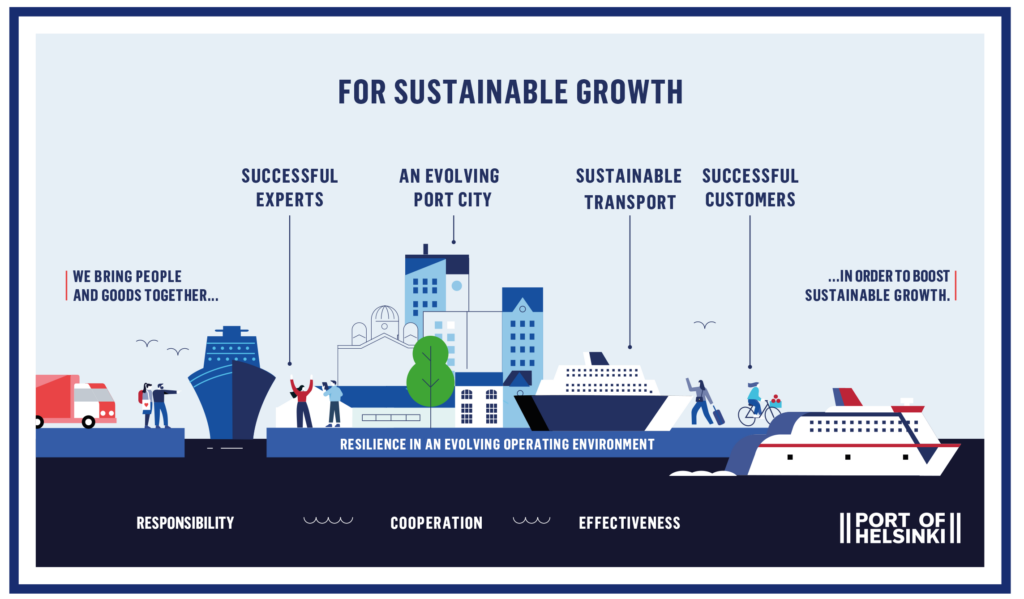
Carbon neutral by 2025
Many of the last strategy period’s investments will start bearing fruit for the port and its customers during the current period. “A seamless passenger experience” was one of the key themes of the previous strategy, and a lot of work was done to understand the port’s end customers.
“We didn’t conduct any regular passenger surveys before, but now we continuously monitor customer satisfaction. Managing and developing the passenger experience has thereby become an established part of our daily work,” says Haapasaari.
Another theme from the previous strategy period – “efficient port operations” – has likewise become a routine practice. It involved developing the port’s operations and digital services, and can be seen in things such as automated gates at terminals.
“The kind of automation used at gates, and how you handle information exchange between vessels and the port, are essential tools in ensuring smooth land and vessel traffic. We’ve already developed a lot of services for passengers, such as parking and restaurants, so now it’s more a question of marketing them,” says Haapasaari.
The port’s vision of recovery is most visible in the key theme of “successful customers”, while its vision of sustainability will be achieved through the key theme of “sustainable transport”. In its previous strategy, the Port of Helsinki was already aiming to be a forerunner in sustainable development, and the most concrete indication of this was its carbon neutral programme. The initial target was 2035. However, last year the port brought the target for its own operations forward to 2030, and its new strategy aims to achieve carbon neutrality in the port’s own operations by 2025.
“We also want to increase our handprint outside the port, that is, how we can contribute to making the transport chain even greener in general,” says Haapasaari.
For example, he says that cooperation between counterports can create green corridors in which similar action taken by several ports will have a wider impact.
The strategy’s third key theme is “an evolving port city”. In practice, this means implementing the development programme drawn up during the last strategy period. The development programme’s investments should be authorised and planned during the 2023–2028 strategy period. The programme pipeline should therefore be ready by about 2028, although the programme itself will extend into the 2030s. The development programme is a package, and the implementation of certain parts will both affect other phases of the programme and have an impact outside the port.
“Over the next few years, the main issue will be how to handle traffic arrangements both inside and outside the port once major construction work begins.”
The first step in the implementation of the development programme will be the demolition of the Makasiini Terminal in the South Harbour next year. In a few years’ time, a museum of architecture and design will be built on this site, and the port will be left with a smaller operating area in the South Harbour.
Vuosaari to play a lead role
The key theme of “an evolving port city” takes its name from the fact that it will be coordinating the Port’s activities with those of the City. In addition to implementing the development programme, developing Vuosaari Harbour also plays a lead role in the strategy. Until now, there had been no plans to expand Vuosaari Harbour until the mid-2030s.
“But we’ll probably start preliminary studies on the expansion of Vuosaari as early as next year, with the idea that the expansion could already begin in stages sometime in the second half of this decade,” says Haapasaari.
The fourth key theme – “successful experts” – naturally tells us who will implement all of the above.
“Investing in competence is something that will essentially remain unchanged from our previous strategy, but due to changes in the operating environment and requirements, we’ll have to invest in personnel competence over the coming strategy period as well, and develop the port as an excellent place to work.”
The next step is to draw up a concrete plan of action based on the key strategic themes.
“Our existing values – responsibility, cooperation and profitability – will not be going anywhere. In terms of responsibility in particular, the safety of the port area as a shared workplace will continue to be a focal point in our operational activities in terms of occupational health and safety, passenger safety and cargo security. The issue of resilience will also rise alongside it,” says Haapasaari.
We want to increase our handprint outside the port.
The strategy is, above all, a roadmap for the port’s own activities.
However, the 120-page document has also been published on the port’s website to illustrate and communicate the key objectives and themes of the port’s strategy.



